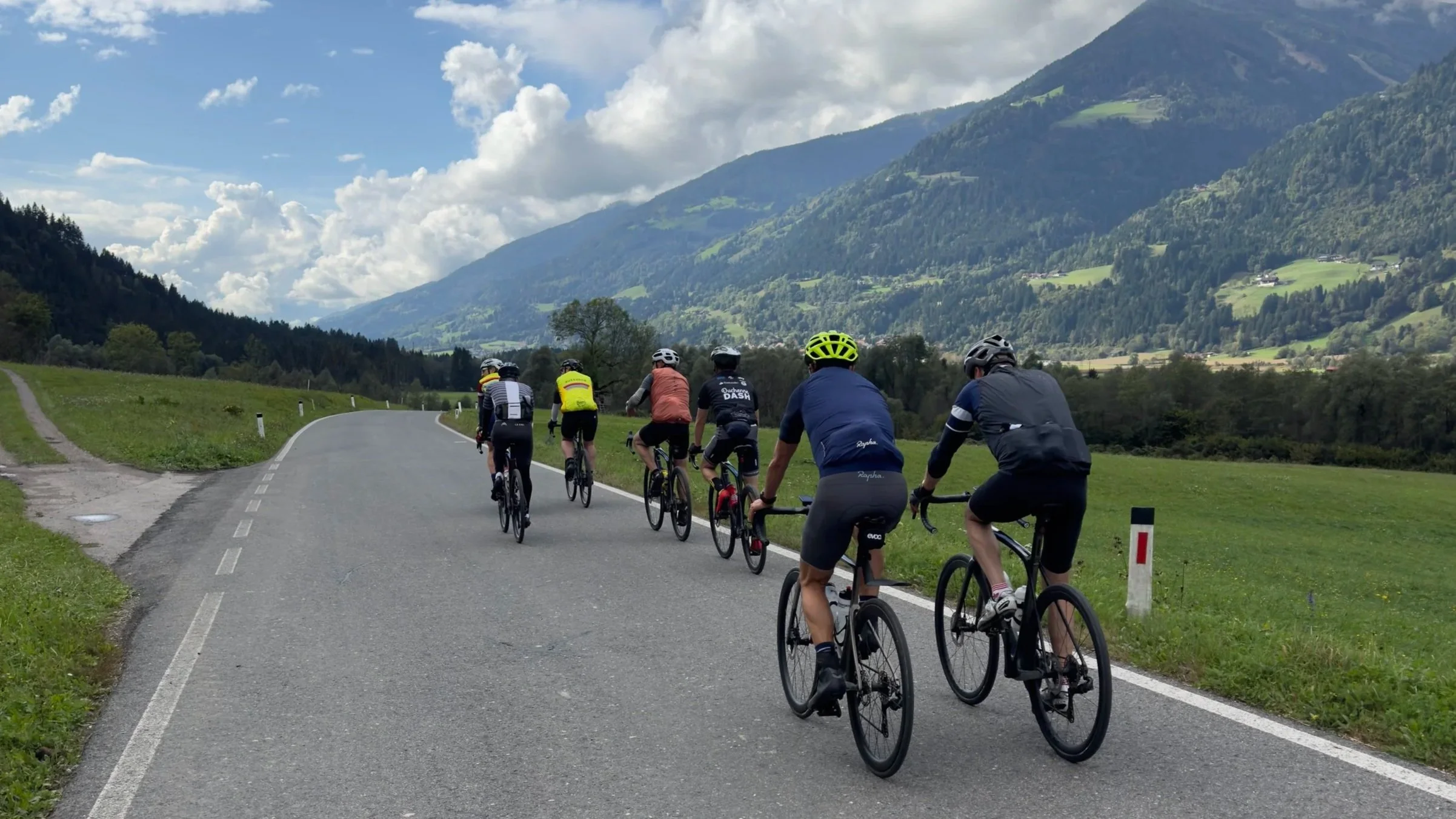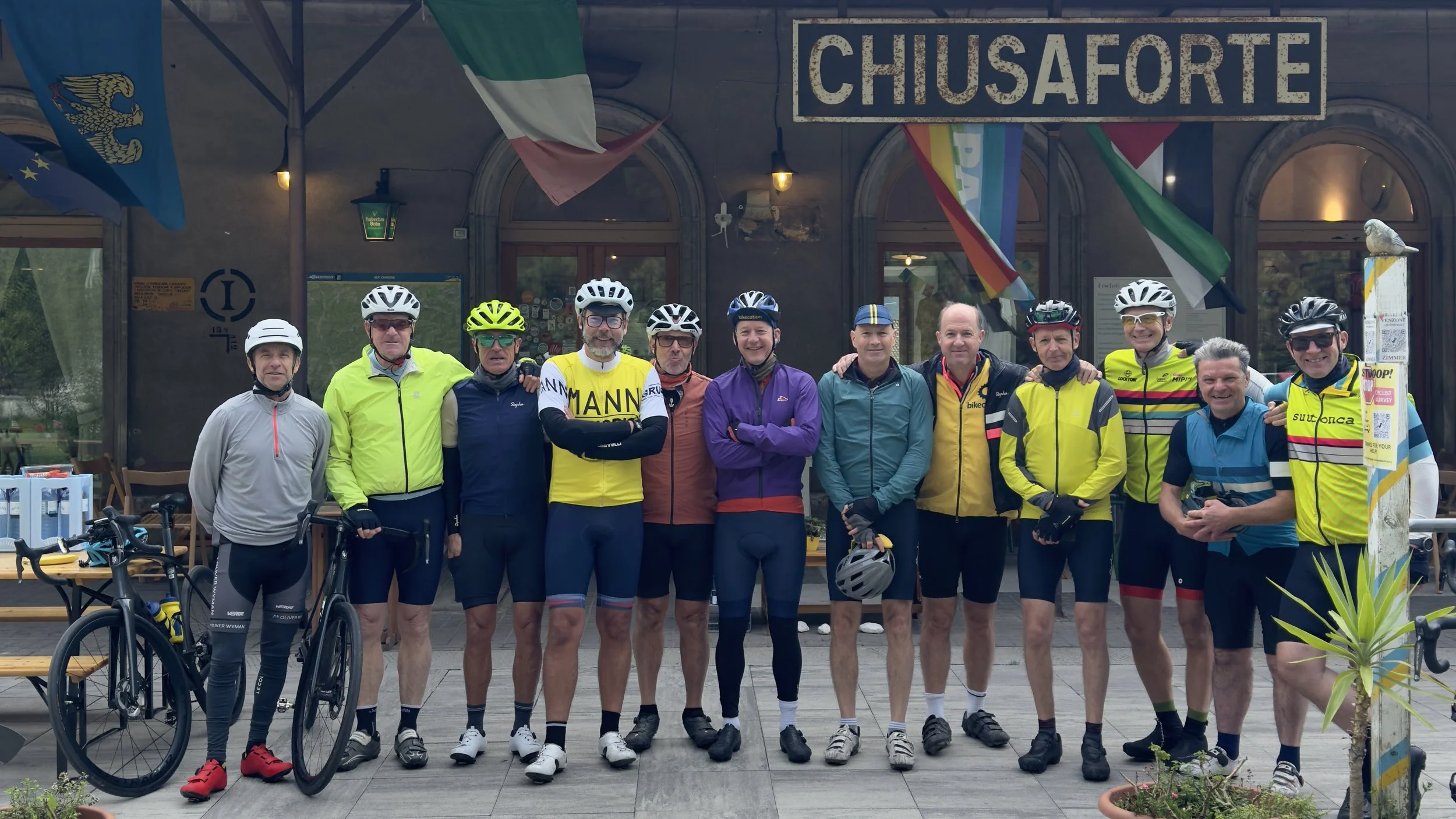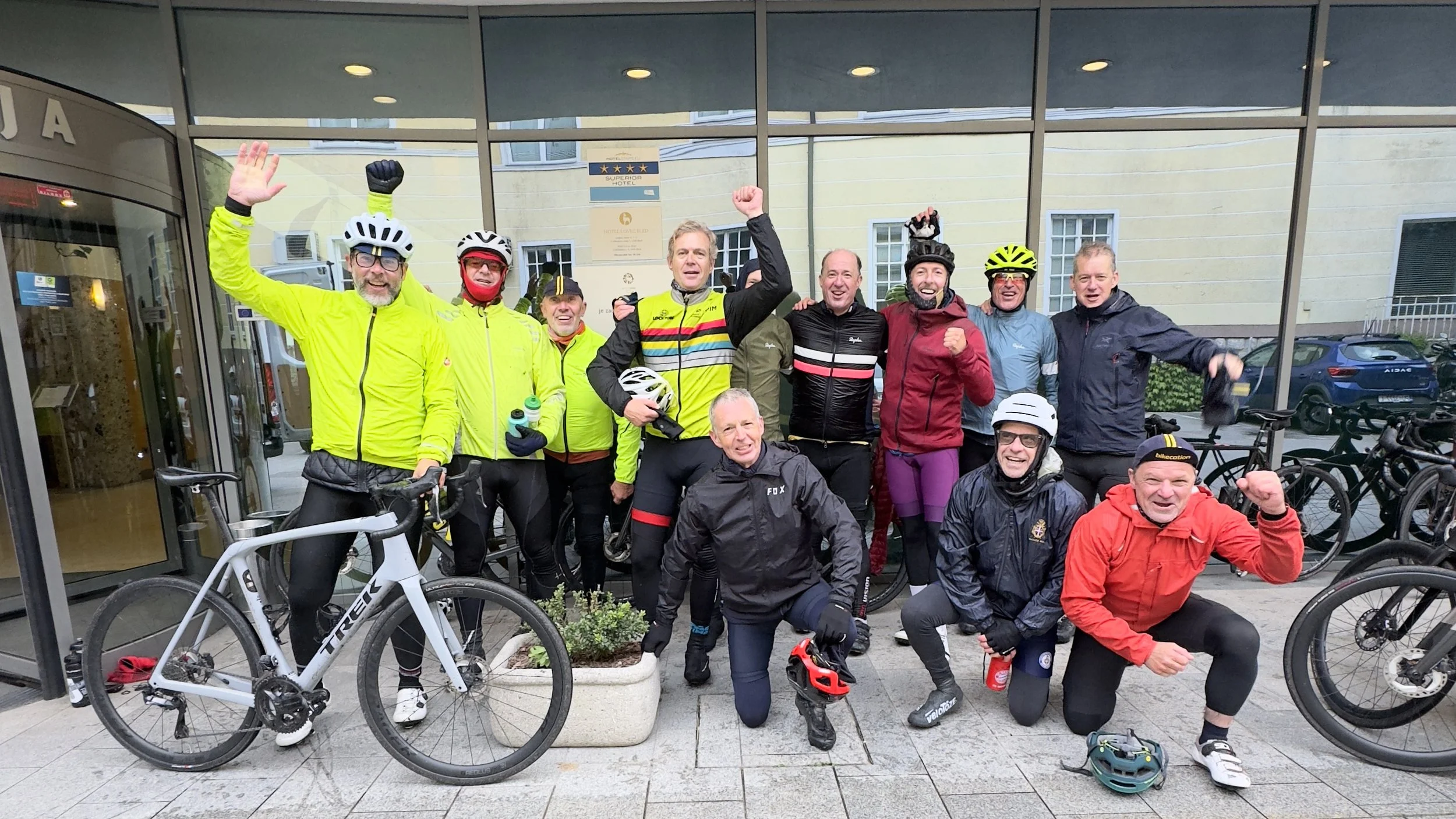We Ride TransAlp: 5 Days, 3 Countries — 1 Unforgettable Ride
Austria to Slovenia — a journey defined by a simple goal, laughter, and the kind of memories you never forget. Here’s how it unfolded, stage by stage.
TransAlp Route
There’s a moment on every long ride when you realise it’s no longer about distance — it’s about the people beside you, the rhythm you fall into, and the simple act of turning pedals together.
For us, that moment came somewhere between seeing the group conquer the Nassfeld Pass and guiding them down the descent into Pontebba — once the border between the Austro-Hungarian north and the Italian south. The landscape changed, the language shifted, yet the feeling stayed the same: tired legs, quiet roads, and the calm sense of being exactly where we wanted to be.
That’s what a TransAlp is really about. Not a race across the map, but a shared journey — five days, three countries, from Kitzbühel to Lake Bled. No numbers, no pressure. Just the roads, the stories, and the quiet cadence that disconnects you from everyday life and reconnects you with each other.
Pre-Trip: Building the Experience
But moments like that don’t just happen. They’re planned — through preparation, patience, and more late-night WhatsApps than I’d like to admit, making sure every small detail worked when it needed to (for the record, we still made plenty of mistakes).
We wanted every part of this trip to feel considered — from scouting the route weeks in advance and hiring a van big enough to handle every scenario, to meeting the riders for the first time and prepping bikes the day before the start, right down to organising bags and setting up the early-morning snack table.
Our goal was simple: remove every small friction so riders could focus on the ride itself. When people feel looked after, they relax, ride better, talk more, and remember longer.
Day 1 – Finding Our Rhythm
Kitzbühel → Zell am See
( 72.4km | 680m | 4h 21 )
Hotel Henri Kitzbühel - The starting point for our Transalp Adventure
The first day is always about settling in. After a deliberately late start to let everyone recover from travel, we focused on learning each other’s pace, hand signals, and unspoken rhythm. Quiet backroads led through the Pillersee valley towards Leogang, where our first small routing hiccup was quickly forgiven once waffles at Mama Thresl restaurant appeared — not a tradition, but it definitely should become one.
By late afternoon we rolled into Zell am See and the timeless Hotel Tirolerhof. A few riders jumped straight into the lake before refuelling on warm snacks at the bar — the start of a five-day battle with calorie balance. It all felt easy, relaxed — exactly the start we’d hoped for.
But there was an elephant in the room. Just a day earlier, snow had fallen in the Hohe Tauern National Park — home to Austria’s highest mountain, the Großglockner (3,798 m). Would the High Alpine Pass be open for tomorrow’s Queen Stage?
A few frantic Google searches and two unanswered calls later, I rang a mountain restaurant at the summit. The woman who answered didn’t sugar-coat it:
“Schatzi (Austrian for Babe), I’m looking out the window now — there’s ten centimetres of snow. I promise you, you can’t ride it, even if you’re Tadej Pogačar. And I’m guessing you’re not!”
Breaking the news to the group could have been a psychological study in itself. Within thirty seconds the tone shifted from “Is it safe?” to “Are you sure we really can’t do it? Maybe call them again?” It was a good lesson in managing expectations.
Day 2 – A Detour Through the High Country
Zell am See → Oberdrauberg via Bad Gastein
( 127.2km | 1,230m | 5h 42 )
Gajach next to the River Drau
With the Großglockner closed, we rerouted through Bad Gastein and took the short train through the mountain tunnel. The ride there offered everything: riverside roads along the Salzach, sections beside the highway, and finally peaceful paths framed by glimpses of the local summits.
Riding through Bad Gastein — its grand, faded architecture a reminder of 19th-century spa-town glory — it became clear we were cutting it close for the train. One stop early, the group boarded, only to discover that this service didn’t take bikes without advance booking. After some creative negotiation with the ticket master (thank you, team), the bikes were eventually stowed neatly in the postal carriage — where there was easily room for twenty more. You have to love the reluctant flexibility that hides behind Austria’s rigid rules.
Fifteen minutes later we rolled out in Mallnitz-Obervellach — essentially a train station in a field — and began our descent in light drizzle. At the bottom we stumbled across Grillkunst, where the waitress handled twelve wet cyclists with flawless calm, taking every order correctly and delivering what became our first hot lunch of the trip (schnitzel was the clear winner).
The final sixty kilometres to our stop in Oberdrauberg were flat and fast. That night, Gasthof Post buzzed with locals, laughter, and hearty food. Not polished, but real — the kind of place that will likely never change.
Day 3 – Into Italy
Oberdrauberg → Tarvisio via Nassfeld Pass
( 86.96km | 1,663m | 6h 43 )
Early climb from Oberdrauberg to Gailberg.
Our first big climbing day. Straight out of town: ten switchbacks and seven hundred vertical metres over the Gailberg Pass to coffee in Kötschach.
Caffeine loaded, we battled a stiff headwind across the valley to the foot of the Nassfeld Pass. With 150 km already in the legs from the previous days, everyone knew the drill: find a rhythm and hold it. At the summit, Markus — our driver, mechanic, head of catering, and undisputed team MVP — had set up a feed station with drinks and snacks. He’d been up early, visiting the bakery next to our hotel to organise homemade sandwiches — which somehow tasted better at 1,530 m than any café ever could.
The descent over Passo Pramollo into Italy was pure joy — arched bridges, tunnels carved through rock, endless flow. By late afternoon, we rolled into Tarvisio, sunshine on our backs. A few beers on the terrace followed, along with the kind of stories that only get better with time. Dinner at Hotel Edelhof was regional comfort at its best: mushroom risotto, roast pork, tiramisu. Simple. Perfect.
Day 4 – The Big One
Tarvisio → Bovec via Sella Nevea & Mangart
( 103.74km | 2,134m | 8h 11 )
One of the many switchbacks on the Mangart
A day we’ll all remember. The bike path out of Tarvisio was breathtaking — towering mountains, smooth tarmac, and the kind of morning light that makes you forget you’ve already ridden three days. There was a brief close call in the tunnel, but let’s just say we all remembered to turn our lights on after that section. A quick espresso stop in Chiusaforte set us up for the climb to Sella Nevea — not one to underestimate at 17.8 km, 793 vertical metres, with pinches of 13 %.
Lunch waited for us by Lago di Predil, a spot we’d scouted weeks earlier, with food from our favourite deli in Tarvisio, Dawit — a place that had saved us from starving on a previous trip during the Ferragosto holidays. Then came the mighty Mangart.
At 2,055 m, the highest road (not pass) of the trip delivered everything: hairpins, mist, and that quiet sense of achievement you can’t fake. Every rider made it to the top. The descent into Bovec was long and fast — at times dangerously so, with no barriers — yet pure flow all the way down. Our hotel greeted us with schnapps, and the laughter that night was the sound of a group — some who’d known each other since school — truly (re)connecting.
Day 5 – Over the Pass
Bovec → Lake Bled via Vršič Pass
( 80.77km | 1,613m | 7h 19 )
Fantastic coffee stop at Statione di Chiusaforte.
The only day that truly made me nervous. The highest pass in Slovenia, Vršič (1,611 m), was officially closed to cars, but everyone we spoke to said, “You can always get through with a bike.”
The first 18 km followed the Soča River — that surreal turquoise colour created by limestone and glacial minerals — before the climb began: steady, steep, and stunning.
Two-thirds of the way up, a message from the first rider flashed on my bike computer: the top was blocked. Not ideal — but we had a plan. The first half of the group would ride through while we “negotiated” with the road crew (sorry, Slovenian Highway Services). Once half the team was past, they couldn’t really stop the rest. After some back-and-forth — and what I can only assume were Slovenian swear words — we were waved through. At 4 °C, with wind chill hovering around zero, the descent was brutal yet brilliant: scrambling through bushes to avoid freshly laid tarmac, slipping past another group of highway workers, and carefully negotiating the cobbled sections that followed.
We regrouped at Okrepčevalnica in Kranjska Gora for what turned out to be the most needed lunch of the week. Recharged, we set off on the final 1.5 hours of the journey — through the only sustained rain of the trip — towards Lake Bled. Wet feet, exhausted legs, big smiles — the perfect finish.
As hugs and laughter spread through the group, a huge sense of satisfaction — and a touch of relief (at least on my part) — set in. We’d done it: 570 km, 7,500 m of climbing, and every rider finished safe and happy.
That feeling. Arrival in Bled after 5 days
Reflection: What We Learned
Every Transalp teaches you something. These are some of our thoughts having had two weeks to reflect.
A flexible plan beats a perfect one.
Preparation is what makes freedom possible.
Shared effort builds stronger friendships than shared comfort.
And no matter the route, the Alps reward those who ride with intention.
Looking Ahead
The talk of “next year” started even before we’d finished dessert in Bled. The route will change, but the idea won’t — ride together, look after each other, and enjoy every kilometre.
Thanks to everyone who made our first We Ride Transalp possible. You turned an idea into a journey we’ll never forget.
2,055m Slovenia’s highest mountain road.
Author’s note
Written by Sam Tomlin-Kedge, founder of We Ride and qualified cycling guide based in Kitzbühel.
Instagram: @weride_kitzbuehel








